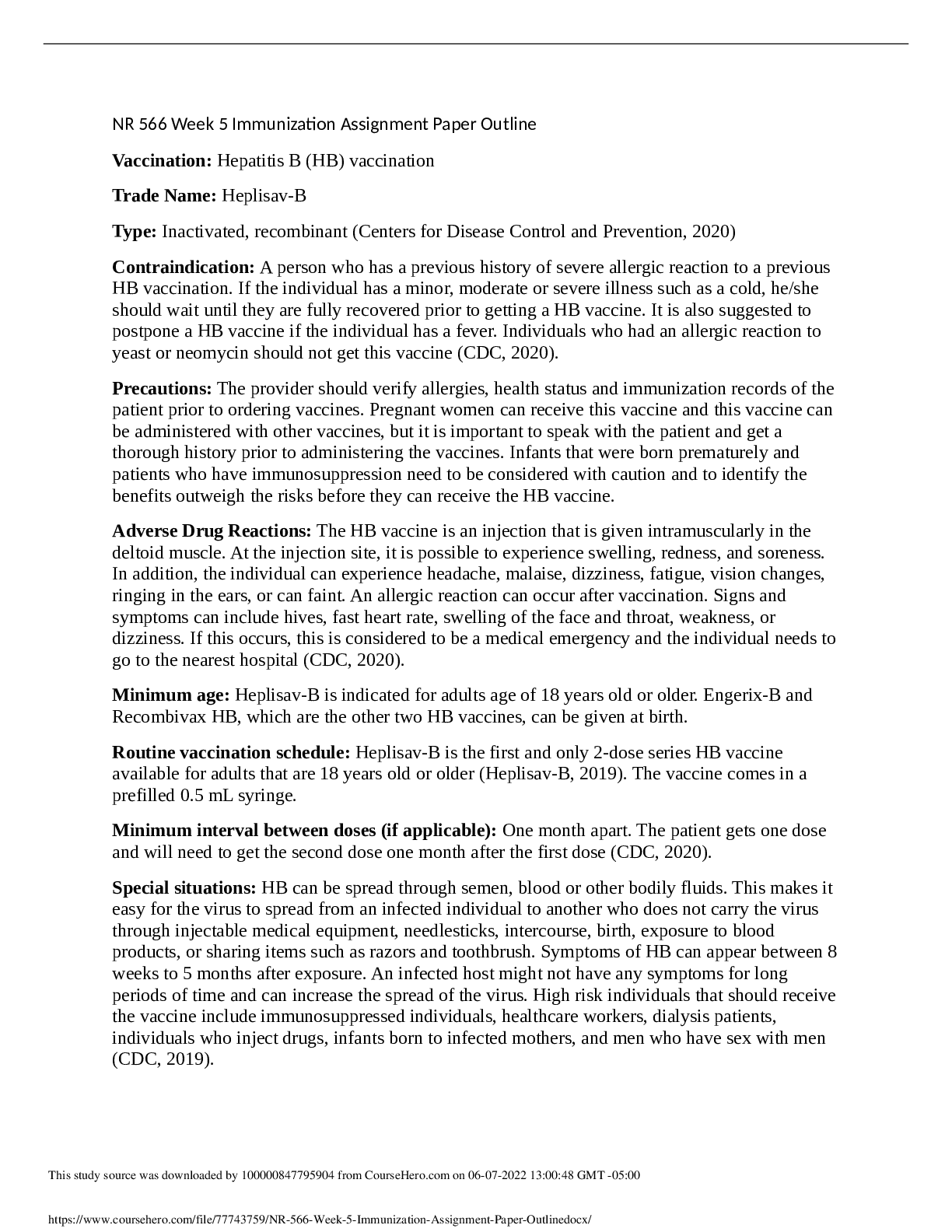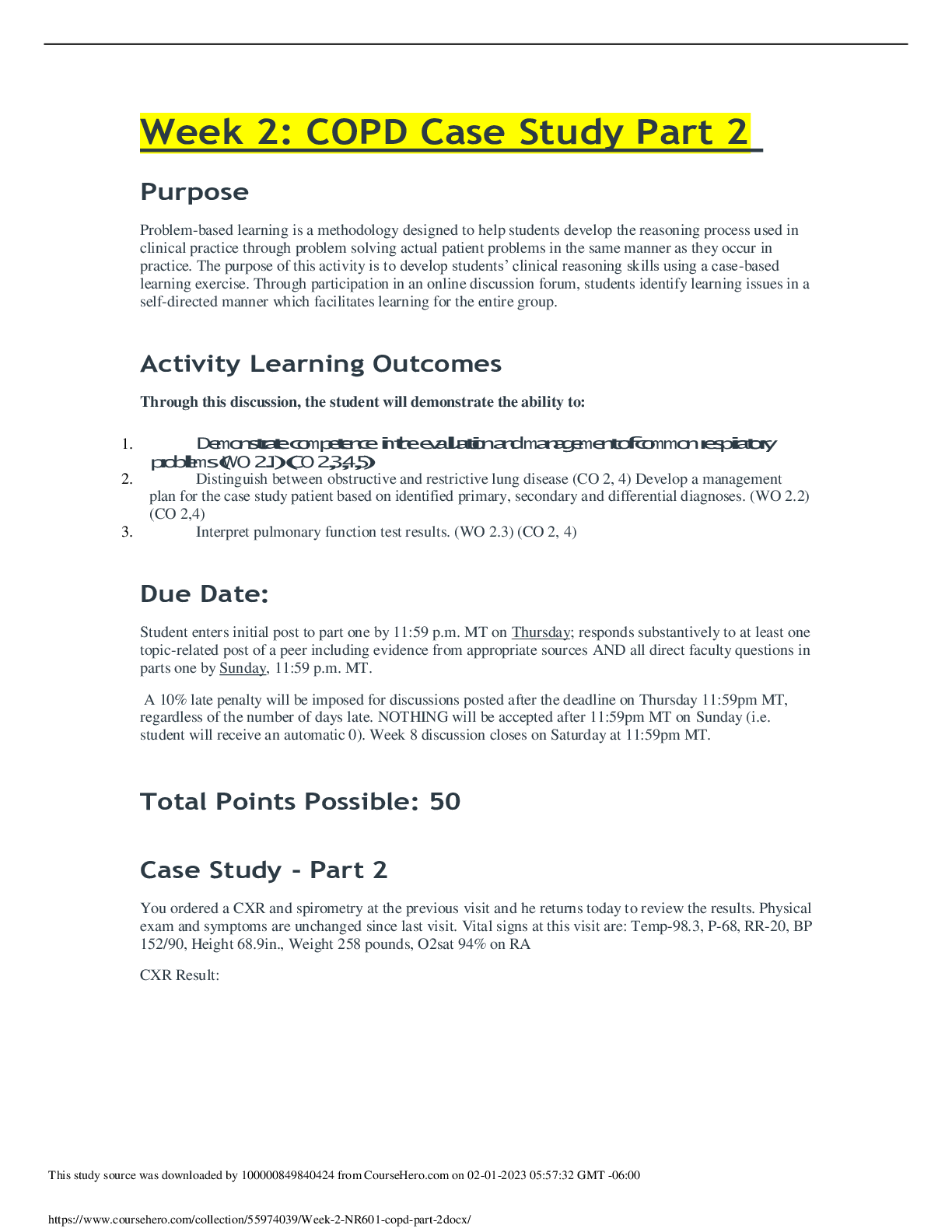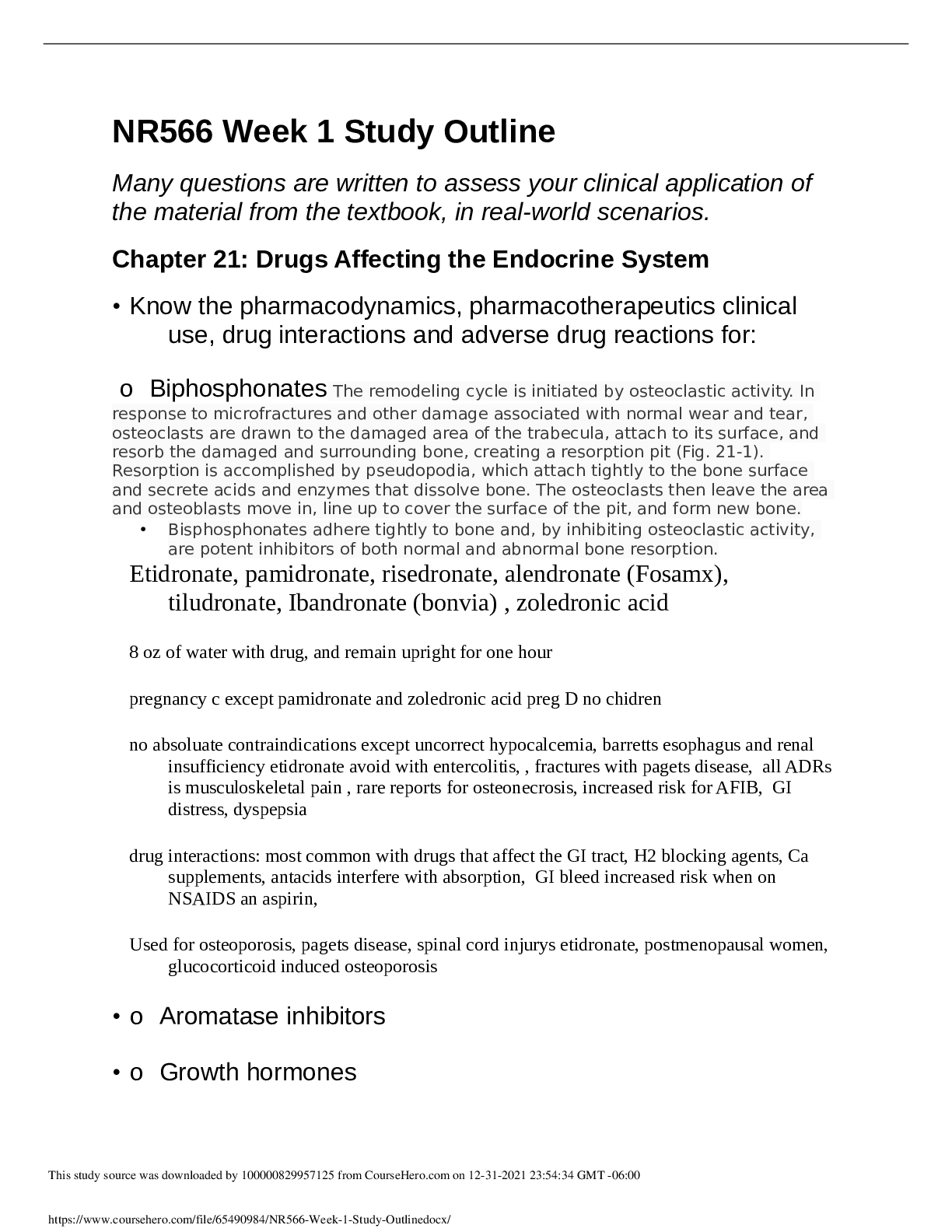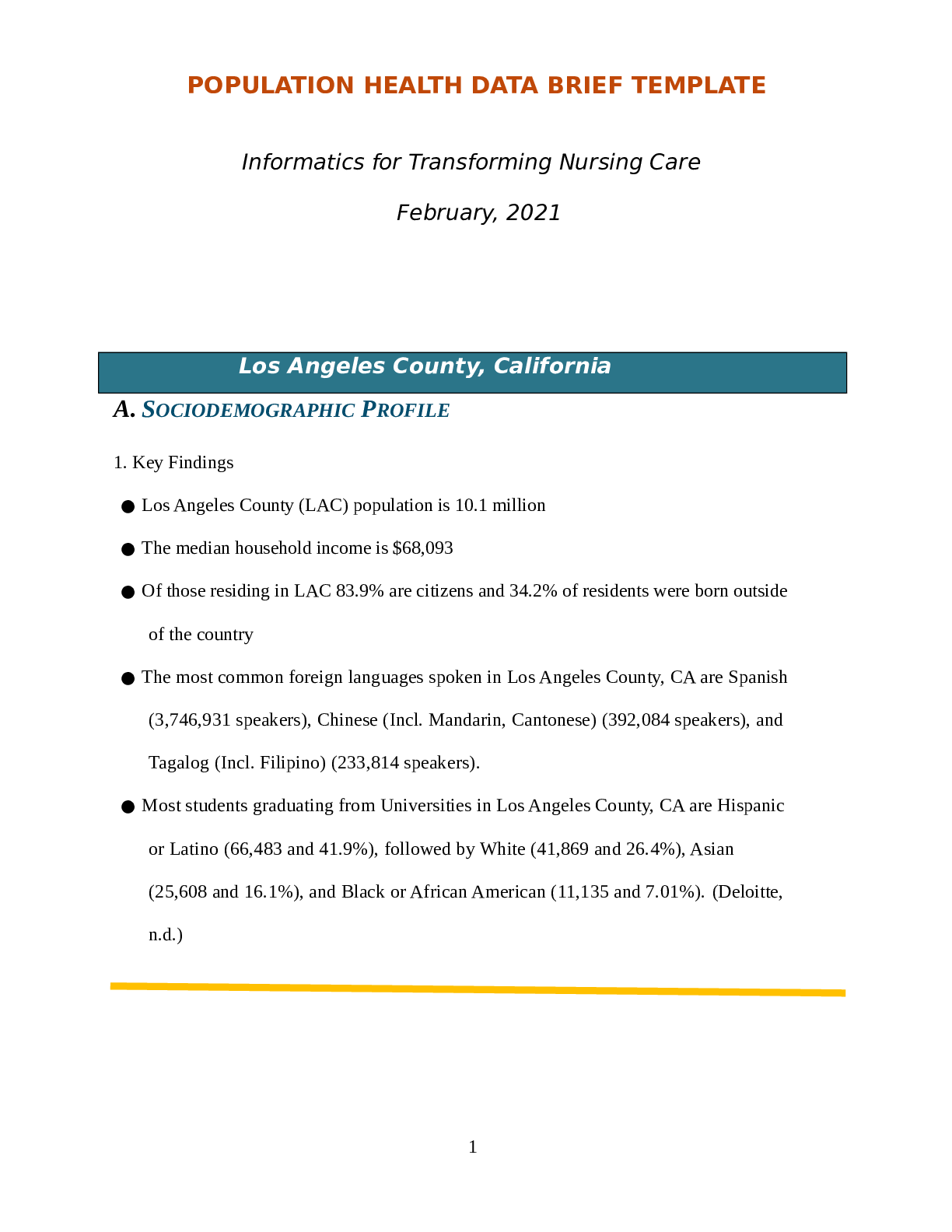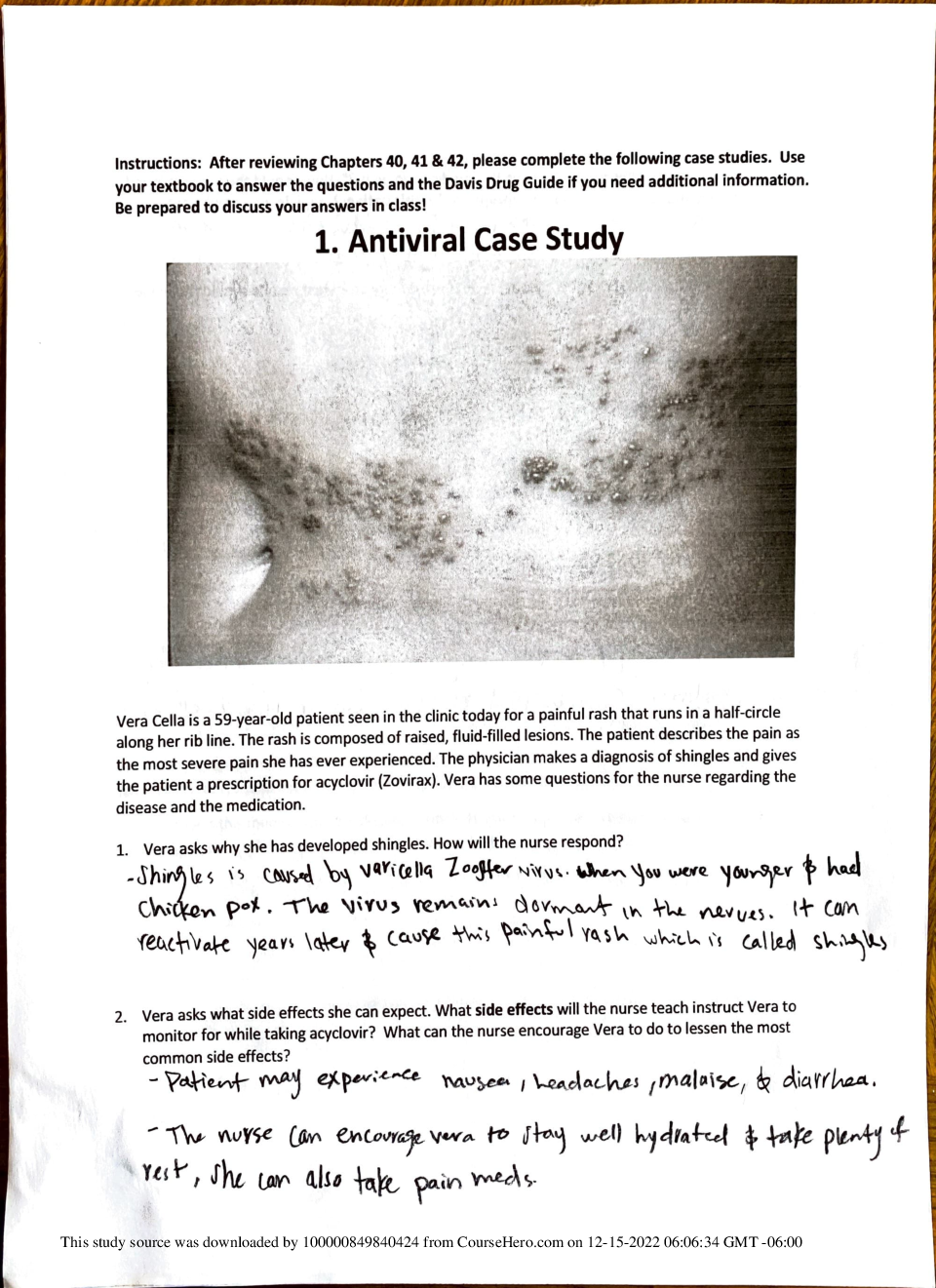*NURSING > CASE STUDY > HUMANITIES HSC235 Assignment 2: Assessing and TreatingPatients With Sleep/Wake Disorders (GRADED A) (All)
HUMANITIES HSC235 Assignment 2: Assessing and TreatingPatients With Sleep/Wake Disorders (GRADED A)
Document Content and Description Below
Excelsior University • HUMANITIES HSC235 Assignment 2: Assessing and Treating Patients With Sleep/Wake Disorders Sleep disorders are conditions that result in changes in an individual’s ... pattern of sleep (Mayo Clinic, 2020). Not surprisingly, a sleep disorder can affect an individual’s overall health, safety, and quality of life. Psychiatric nurse practitioners can treat sleep disorders with psychopharmacologic treatments, however, many of these drugs can have negative effects on other aspects of a patient’s health and well-being. Additionally, while psychopharmacologic treatments may be able to address issues with sleep, they can also exert potential challenges with waking patterns. Thus, it is important for the psychiatric nurse practitioner to carefully evaluate the best psychopharmacologic treatments for patients that present with sleep/wake disorders. To prepare for this Assignment: • Review this week’s Learning Resources, including the Medication Resources indicated for this week. • Reflect on the psychopharmacologic treatments you might recommend for the assessment and treatment of patients with sleep/wake disorders. The Assignment: 5 pages Examine Case Study: Pharmacologic Approaches to the Treatment of Insomnia in a Younger Adult. You will be asked to make three decisions concerning the medication to prescribe to this patient. Be sure to consider factors that might impact the patient’s pharmacokinetic and pharmacodynamic processes. At each decision point, you should evaluate all options before selecting your decision and moving throughout the exercise. Before you make your decision, make sure that you have researched each option and that you evaluate the decision that you will select. Be sure to research each option using the primary literature. Introduction to the case (1 page) • Briefly explain and summarize the case for this Assignment. Be sure to include the specific patient factors that may impact your decision making when prescribing medication for this patient. Decision #1 (1 page) • Which decision did you select? • Why did you select this decision? Be specific and support your response with clinically relevant and patient-specific resources, including the primary literature. • Why did you not select the other two options provided in the exercise? Be specific and support your response with clinically relevant and patient-specific resources, including the primary literature. • What were you hoping to achieve by making this decision? Support your response with evidence and references to the Learning Resources (including the primary literature). • Explain how ethical considerations may impact your treatment plan and communication with patients. Be specific and provide examples. Decision #2 (1 page • Why did you select this decision? Be specific and support your response with clinically relevant and patient-specific resources, including the primary literature. • Why did you not select the other two options provided in the exercise? Be specific and support your response with clinically relevant and patient-specific resources, including the primary literature. • What were you hoping to achieve by making this decision? Support your response with evidence and references to the Learning Resources (including the primary literature). • Explain how ethical considerations may impact your treatment plan and communication with patients. Be specific and provide examples. Decision #3 (1 page) • Why did you select this decision? Be specific and support your response with clinically relevant and patient-specific resources, including the primary literature. • Why did you not select the other two options provided in the exercise? Be specific and support your response with clinically relevant and patient-specific resources, including the primary literature. • What were you hoping to achieve by making this decision? Support your response with evidence and references to the Learning Resources (including the primary literature). • Explain how ethical considerations may impact your treatment plan and communication with patients. Be specific and provide examples. Conclusion (1 page) • Summarize your recommendations on the treatment options you selected for this patient. Be sure to justify your recommendations and support your response with clinically relevant and patient-specific resources, including the primary literature. BACKGROUND This week, we examine a 31-year-old male who presents to the office with a chief complaint of insomnia. SUBJECTIVE Patient is a 31-year-old male. He states that his insomnia has gotten progressively worse over the past 6 months. Per the patient, he has never been a “great sleeper” but is now having difficulty both falling asleep and staying asleep at night. The problem began approximately 6 months ago after the sudden loss of his fiancé. The patient states this is affecting his ability to perform his job, which is a forklift operator at a local chemical company. The patient states he has used diphenhydramine in the past to sleep but does not like the way it makes him feel the morning after. He states he has fallen asleep on the job due to lack of sleep from the night before. The patient's medical record from his previous physician states that he has a history of opiate abuse, which began after he broke his ankle in a skiing accident and was prescribed hydrocodone/apap (acetaminophen) for acute pain management. The patient has not received a prescription for an opiate analgesic in 4 years. The patient states recently he has been using alcohol to help him fall asleep, approximately four beers prior to bed. MENTAL STATUS EXAM The patient is alert and oriented to person, place, time, event. He makes good eye contact and is dressed appropriately for time of year. He denies auditory/visual hallucinations. Judgement, insight, and reality contact are all intact. Patient denies suicidal/homicidal ideation and is future oriented. Please start paper by inquiring about patient’s sleep hygiene Decision Point One StartTrazadone50-100mgatbedtim Trazodone RESULTS OF DECISION POINT ONE • Patient returns to clinic in 2 weeks • Patient states medication works well but gives him an unpleasant side effect of a prolonged erection of the penis, approximately 15 minutes after waking • Patient states this makes it difficult to get ready for work or go downstairs and have coffee with his girlfriend and daughter in the morning • Patient denies auditory/visual hallucinations and is future oriented Decision Point Two: RESULTS OF DECISION POINT TWO • Patient returns to clinic in 2 weeks • Patient states priapism has diminished over time • Patient denies auditory/visual hallucinations and is future oriented • Patient states trazodone is effective at 50 mg dose but sometimes wakes up following day with next-day drowsiness • Patient denies auditory/visual hallucinations and is future oriented Decision Point Three Guidance to Student Trazodone is a selective serotonin reuptake inhibitor that has a low side effect profile. It would not be prudent to prescribe sonata as it carries with it the risk of complex sleep behaviors. Hydroxyzine is an antihistamine with strong sedative properties. However, many patients complain of anticholinergic adverse effects the following morning, such as Xerostomia and Xerophthalmia. The patient is presenting with excessive somnolence. It would be prudent to reduce the dose of trazodone by 50% and reassess in 4 weeks. Learning Resources Required Readings (click to expand/reduce) American Psychiatric Association. (2013). Diagnostic and statistical manual of mental disorders (5th ed.). https://doi.org/10.1176/appi.books.9780890425596 Fernandez-Mendoza, J., & Vgontzas, A. N. (2013). Insomnia and its impact on physical and mental health. Current Psychiatry Reports, 15(12), 418. https://doi.org/10.1007/s11920-012-0418-8 Levenson, J. C., Kay, D. B., & Buysse, D. J. (2015). The pathophysiology of insomnia. Chest, 147(4), 1179–1192. https://www.ncbi.nlm.nih.gov/pmc/articles/PMC4388122/ Morgenthaler, T. I., Kapur, V. K., Brown, T. M., Swick, T. J., Alessi, C., Aurora, R. N., Boehlecke, B., Chesson, A. L., Friedman, L., Maganti, R., Owens, J., Pancer, J., & Zak, R. (2007). Practice parameters for the treatment of narcolepsy and other hypersomnias of central origin. SLEEP, 30(12), 1705–1711. https://j2vjt3dnbra3ps7ll1clb4q2- wpengine.netdna-ssl.com/wp- content/uploads/2017/07/PP_Narcolepsy.pdf Morgenthaler, T. I., Owens, J., Alessi, C., Boehlecke, B, Brown, T. M., Coleman, J., Friedman, L., Kapur, V. K., Lee-Chiong, T., Pancer, J., & Swick, T. J. (2006). Practice parameters for behavioral treatment of bedtime problems and night wakings in infants and young children. SLEEP, 29(1), 1277–1281. https://j2vjt3dnbra3ps7ll1clb4q2- wpengine.netdna-ssl.com/wp- content/uploads/2017/07/PP_NightWakingsChildren.pdf Sateia, M. J., Buysse, D. J., Krystal, A. D., Neubauer, D. N., & Heald, J. L. (2017). Clinical practice guideline for the pharmacologic treatment of chronic insomnia in adults: An American Academy of Sleep Medicine clinical practice guideline. Journal of Clinical Sleep Medicine, 13(2), 307–349. https://jcsm.aasm.org/doi/pdf/10.5664/jcsm.6470 Winkleman, J. W. (2015). Insomnia disorder. The New England Journal of Medicine, 373(15), 1437–1444. https://doi.org/10.1056/NEJMcp1412740 • [Show More]
Last updated: 1 year ago
Preview 1 out of 6 pages
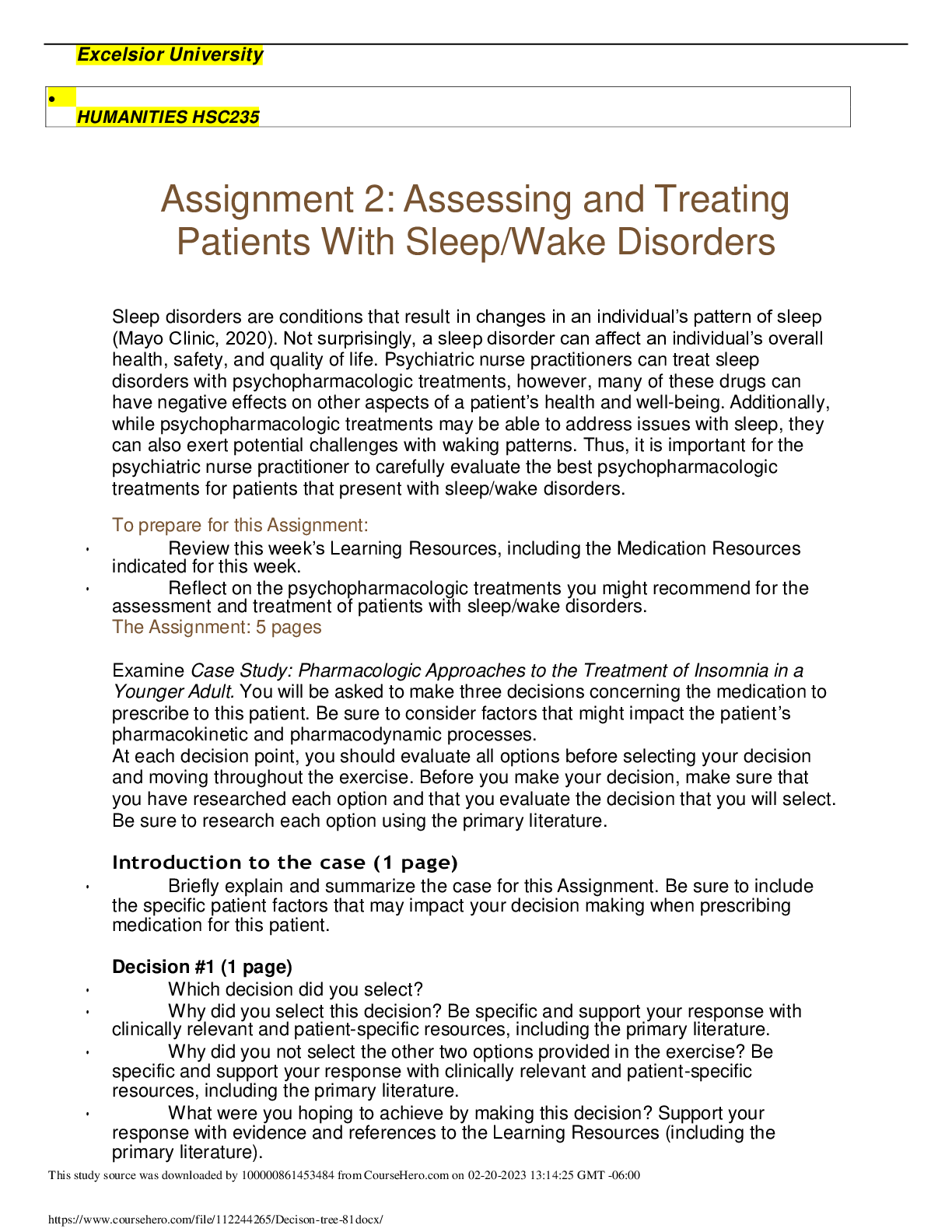
Buy this document to get the full access instantly
Instant Download Access after purchase
Add to cartInstant download
We Accept:

Reviews( 0 )
$7.50
Document information
Connected school, study & course
About the document
Uploaded On
Feb 20, 2023
Number of pages
6
Written in
Additional information
This document has been written for:
Uploaded
Feb 20, 2023
Downloads
0
Views
67




